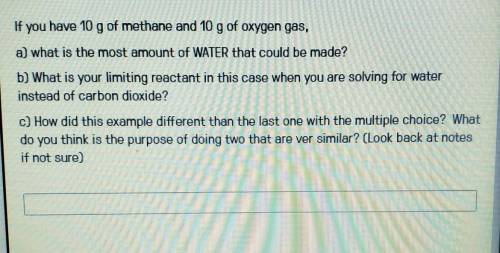If you have 10 g of methane and 10 g of oxygen gas,
a) what is the most amount of WATER that co...

If you have 10 g of methane and 10 g of oxygen gas,
a) what is the most amount of WATER that could be made?
b) What is your limiting reactant in this case when you are solving for water
instead of carbon dioxide?
c) How did this example different than the last one with the multiple choice? What
do you think is the purpose of doing two that are ver similar?
Please help! I suck at chemistry!


Answers: 1


Another question on Chemistry

Chemistry, 21.06.2019 14:30
Alculate the concentration of h3o⁺in a solution that contains 5.5 × 10-5m oh⁻at 25°c. identify the solution as acidic, basic, or neutral.a) 1.8 × 10-10m, basicb) 1.8 × 10-10m, acidicc) 5.5 × 10-10m, neutrald) 9.2 × 10-1m, acidice) 9.2 × 10-1m, basic
Answers: 1

Chemistry, 21.06.2019 20:50
Which real-world scenarios below represent physical and chemical changes? -running a car -exploding fireworks -mixing water and powdered drink mix -combining oil and vinegar to make salad dressing -taking aspirin for a headache -diluting bleach with water-digesting dinner-spreading peanut butter on bread
Answers: 2

Chemistry, 22.06.2019 07:00
How far is the region from the equator or control climate
Answers: 1

Chemistry, 22.06.2019 10:20
In a reaction equation, where are the products located? a.) above the arrow b.) to the right of the arrow c.) to the left of the arrow d.) below the arrow
Answers: 2
You know the right answer?
Questions

Business, 02.08.2019 13:00

History, 02.08.2019 13:00

English, 02.08.2019 13:00


Biology, 02.08.2019 13:00



Chemistry, 02.08.2019 13:00

Biology, 02.08.2019 13:00

Mathematics, 02.08.2019 13:00

Mathematics, 02.08.2019 13:00

English, 02.08.2019 13:00



Mathematics, 02.08.2019 13:00

English, 02.08.2019 13:00

History, 02.08.2019 13:00

Mathematics, 02.08.2019 13:00


History, 02.08.2019 13:00



